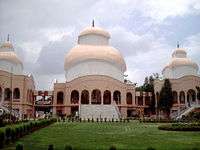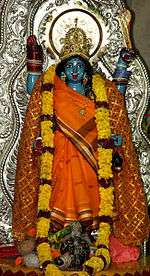Chittaranjan Park

| Chittaranjan Park | |
|---|---|
| neighbourhood | |
 Chittaranjan Park Location in Delhi, India | |
| Coordinates: 28°32′23″N 77°14′52″E / 28.539592°N 77.247699°ECoordinates: 28°32′23″N 77°14′52″E / 28.539592°N 77.247699°E | |
| Country |
|
| State | Delhi |
| District | New Delhi (formerly South Delhi) |
| Metro | New Delhi |
| Languages | |
| • Official | Hindi |
| Time zone | IST (UTC+5:30) |
| PIN | 110 019 |
| Planning agency | Municipal Corporation of Delhi |
Chittaranjan Park (Bengali: চিত্তরঞ্জন পার্ক), also known as C.R. Park, is an affluent neighbourhood in South Delhi, and home to a large Bengali community. It was established in the early 1960s under the name EPDP Colony or East Pakistan Displaced Persons Colony, and later renamed after the deshbandhu (patriot) Chittaranjan Das in the 1980s.[1] Today, despite its growing cosmopolitan nature, it remains home to a large Bengali community, and is home to Kolkata-style street-food stalls, Bengali cuisine, fish markets, temples and cultural centers.[1]It hosts many festivities and cultural events. Durga Puja is the most celebrated festival here which boasts magnificent marquee.
History
In 1954, an association was formed for the inhabitants from East Bengal who were displaced from their homes in East Pakistan during the Partition of India and the associated Partition of Bengal (1947). A large group of government officers hailing from the erstwhile East Bengal migrated to Delhi and lobbied for a residential neighbourhood. Leading roles were taken by Chandra Kumar Mukherjee,[1] Subodh Gopal Basumallik, Ashutosh Dutta, Bimal Bhusan Chakraborty, and the Chief Election Commissioner, Shyamaprasanna Senverma.[2] In the 1960s, land was assigned in a barren rocky area in the-then distant Southern areas. Members were required to provide some documentation of their residential status, and were required to be "already residing in Noida and gainfully employed in the capital"; based on this, 2147 people were given plots of land, initially on lease for 99 years, but subsequently converted into a freehold ownership.[3]
The original layout had the two-thousand odd plots, divided into eleven blocks A-K, along with a number of markets and cultural spaces. However, in the 1990s, 714 displaced families were accommodated among those who had not been able to meet the earlier deadline. This resulted in new blocks, called M, N, O, K-1, K-2, Pocket 40 (referred to as Navapalli), Pocket 52 (referred to as Dakhinpalli ) and Pocket-K. The main thoroughfare of the colony is Bipin Chandra Pal Marg. Institutions of note are a branch of the Raisina Bengali School, Kali Mandir (also called the Shiv Mandir), Bangiya Samaj and Chittaranjan Bhawan.[1]

Chittaranjan Park is bordered by Kalkaji, Greater Kailash I and II, Alaknanda and Govindpuri. It is adjacent to the business centre at Nehru Place.
Demographics
The colony was founded with plots going exclusively to migrants from East Bengal, but over time, the demographics has become a little more pan-Indian, though it continues to attract other Bengalis (West bengal roots) in general. It has emerged as the most important outpost of Bengali culture in the capital. The explosive growth of South Delhi property prices and the ageing of the original land allottees is resulting in an ongoing demographic diversification.[4]
Centre of Bengali Culture in Delhi
The first wave of Bengali settlers came to Delhi in late 1700's and early 1800's. Another essential requirement was that of a Kali Bari. The first Kali Bari of Delhi is the one at Tis Hazari, which still exists. The idol and Kali Bari were first established in 1826 but the temple was destroyed during the 1857 revolt. The idol was later salvaged and a temple built in Roshanpura. The space started to fall short to accommodate the devotees, land was bought and the present temple built at Tis Hazari in 1917. There are more than 25 Kali bari temple and few Durga bari. Moreover, few other temples of bengali faith are also built in different parts of New Delhi and NCR. The first private Durga Puja in Delhi was celebrated in 1842 by one Majumdar of Rajshahi, followed by some other Puja celebrations that continued for a few years. The first baroyari (community-based) Puja is that of Kashmere Gate, first started in 1910 and still celebrated with the same fervour and traditions. Kali Bari in Mandir Marg temple built in 1930. The Big wave of bengali settled when Calcutta and Delhi were first connected by train in 1864, thereafter with the shifting of capital to New Delhi in 1911, the shifting to government employees' followed logically. The Next big wave settled in 1947 and 1971. Initially employees from central government departments like Post and Telegraph, Government of India Press, Accountant General of Central Revenues (AGCR) and Railways were settled in Timarpur; thereafter in 1924, another phase of government housing came up near Gole Market, for employees of the Secretariat. Overtime many employees after retirement settled in Karol Bagh and WEA, and later in South Delhi.[5]
Chittaranjan Park however remains a major centre of Bengali cultural life in New Delhi, the best part is its evening life in the markets and on the streets people doing AddA - a favourite Bengali bhadralok pastime. The Durga Puja celebrations are renowned for their elaborate pandals and cultural functions. The major Durga Puja celebrations are B-Block, Kali Mandir, Co-operative Ground, Mela Ground, and Navapalli (Pocket 40). Auditoriums at Chittaranjan Bhawan and Bipin Pal Bhawan regularly host performances of Bengali theatre and music, which are also occasionally held in the Shiv/Kali Mandir. The week of Durga Puja sees performances by well-known artistes and troupes from West Bengal and Bangladesh as well as performances from group of local people residing at C.R. Park.

Chittaranjan Park is also home to one of the city's main markets for freshwater fish, an integral part of Bengali cuisine, a large Kali temple, several cultural centres, four big markets specialising in Bengali sweets and numerous stalls selling Calcutta-style street food - chops, cutlets, kathi rolls, phuchka and jhaalmuri etc. The best of which can be found around the 4 major markets in the area.
Most of the residents are eminent ex-government servants, scholars, professors, teachers and other professionals.
Access
The Indira Gandhi International Airport is 17 km (domestic) and 23 km (international) from Chittaranjan Park. The New Delhi railway station is 16 km, and the Hazrat Nizamuddin Railway Station 9 km away. The Violet Line of the Delhi Metro has a stop at the Nehru Place station within 1 km from B-block in Chittaranjan Park.
See also
References
- 1 2 3 4 "Chittaranjan Park". Travel Delhi. Mobile Reference. 2007. ISBN 1-60501-051-0.
- ↑ http://epdpassociationcrpark.blogspot.com/2009/02/established-in-1954-and-registered.html
- ↑ "Pin Code of Chittaranjan Park Delhi". citypincode.in. Retrieved 2014-03-09.
- ↑ Hiroshi Ishii; Katsuo Nawa (2007). Social Dynamics in Northern South Asia: Political and social transformations in north India and Nepal. Manohar. p. 311. ISBN 81-7304-729-4.
- ↑ "From Bengal, but staunchly Delhiites". Hindustan Times. July 6, 2011. Archived from the original on 2011-12-04.
- "The bong connect". Hindustan Times. May 26, 2010.